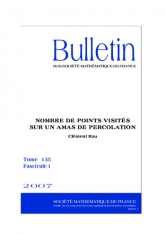Sur le nombre de points visités par une marche aléatoire sur un amas infini de percolation
On the number of distinct visited sites by a random walk on the infinite cluster of the percolation model

- Consulter un extrait
- Année : 2007
- Fascicule : 1
- Tome : 135
- Format : Électronique
- Langue de l'ouvrage :
Français - Class. Math. : 60J10, 60K35
- Pages : 135-169
- DOI : 10.24033/bsmf.2530
On s'intéresse à une marche aléatoire simple sur un amas infini issu d'un processus de percolation surcritique sur les arêtes de $\Z ^d \ (d \geq 2)$ de loi $Q$. On montre que la transformée de Laplace du nombre de points visités au temps $n$, noté $N_n$, a un comportement similaire au cas où la marche évolue dans $\Z ^d$. Plus précisément, on établit que pour tout $0<\alpha <1$, il existe des constantes $C_i$, $C_s >0$ telles que pour presque toute réalisation de la percolation telle que l'origine appartienne à l'amas infini et pour $n$ assez grand, $ \mathrm e^{-C_i n^{ d/(d+2) } } \leq \E _0^{\omega } ( \alpha ^{N_n} ) \leq \mathrm e^{-C_sn^{d/(d+2) }}. $ Le point principal du travail réside dans l'obtention de la borne supérieure. Notre approche consiste dans un premier temps, à trouver une inégalité isopérimétrique sur l'amas infini, et dans un deuxième temps à la remonter sur un produit en couronne, ce qui nous permet alors d'obtenir une majoration de la probabilité de retour d'une certaine marche sur ce produit en couronne. L'introduction d'un produit en couronne est justement motivée par le fait que la probabilité de retour sur un tel graphe s'interprète comme l'espérance de la transformée de Laplace du nombre de points visités.
Inégalité isopérimétrique, nombre de points visités, percolation, produit en couronne
Prix Papier
Prix public
43.00 €
Prix membre
30.00 €
Quantité

